Sorry it’s been a while since I’ve shared anything; we had another child and work has been demanding. So it’s with great pleasure that I share this article from Outdoor Life (http://outdoorlifes.com/02315efe7cbe62) in its entirety. I thoroughly enjoyed reading this article because this family is playing out many of the things I hope to achieve in life.
Jon
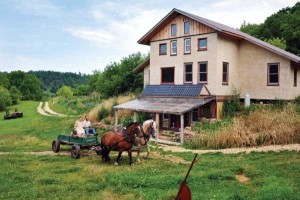
#1 Robert, Summer and their son, Yha’ni, have made their homesteading dreams a reality
In June 2004, my wife, Summer, and I arrived at the 40 vacant acres of grass and woods we had just purchased, nestled in the hills of southwest Wisconsin. Summer was six months pregnant, and we had our work cut out for us to get a warm shelter built before the cold set in. We came with high hopes and a solid work ethic. We also brought with us feelings of freedom, concern from our families, and anxiety over what we were about to embark upon. Both of us had been preparing for this step into self-sufficient life since we were teenagers, saving money and learning old-fashioned skills, natural building techniques, and various arts and crafts (including blacksmithing and fiber arts). We worked on conventional and organic farms, learning to live simply within limited means. We also held several intern positions, participated in WWOOF (World Wide Opportunities on Organic Farms), and spent enough time on other people’s land that we knew we wanted to have our own. As an artist, it had always been my dream to arrive on vacant land and gradually build up my homestead, a lifelong creation.
Our wish list for our dream property included privacy, a quiet road, 20 to 60 acres that were half tillable/half wooded, and, most importantly, a clean spring. Finding all these attributes was not easy, and we looked at more than 40 properties over five months. When we found a parcel that met most of our wishes, our only hesitation was that it was 30 miles from the main social center in the area. In exchange for being so far out, however, we landed amid a thriving Amish community. This was a major attraction for us because we knew people in the community would have rural living skills we could learn. We would also have a direct connection to their horse-drawn lifestyle, and the possibility of borrowing horses and equipment until we got a team of our own.
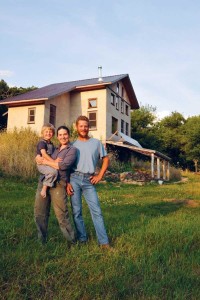
#2 Making Plans
During the land search process, we started to design the home that we planned to build. It was a small, simple, straw bale structure that I thought I could put up in a couple of months. Well, more than five years later, we’re still putting the finishing touches on the house. One of the best bits of advice came from my older sister, who suggested I start by building the walk-out concrete foundation and putting on a temporary roof for the first winter. That gave us three solid walls, and I then framed the south-facing fourth wall, which is 80 percent windows. We could then start early the following spring and frame out the rest of the house without such pressure. This made it possible for us to get a dwelling built by October (our baby was born Oct. 6). Throughout that first winter, we had the time to design and build the home we wanted, using the materials we wanted, without having to rush or make compromises because of time constraints. That winter, the plans for our house grew from 800 square feet to 1,380 square feet, as we realized that having personal spaces to focus on our individual passions would be critical for our overall happiness. Summer has her own room, and I have an office. These rooms are meant to be spaces that we can furnish, decorate, and use in ways that are right for us — self-expression within the family.
After more research and conversations with experienced natural builders in the area, we changed our plan from using straw bales for insulation to building our walls with a straw/clay infill packed into formwork. Why? First and foremost, we learned that mixing the clay slip into the straw before packing the walls assists in the deterrence of potential mold growth. The clay within will absorb any moisture from vapor penetration, and slowly release the moisture, keeping the straw from becoming compromised.
The straw/clay approach also makes it possible to use any wall thickness you desire. We decided to go with 12-inch walls because we wouldn’t have a huge house to keep warm and we didn’t want to lose too much interior space. The 12- inch thickness made it easy to frame, too. Another advantage of straw/clay fill is that it makes it easy to create a flush, “non-wonky-looking” wall, which is often tricky for first-time home builders when trying to stack straw bales. To top it off, the subsoil on our land is pure clay, so we had an unlimited source for not only the infill, but for the multiple coats of plaster we put on. Our base coats were a clay/sand/straw mixture, and for the finish coats we added lime to help with permeability (more lime = less permeable). Our finish coats, inside and out, are a lime-clay plaster, which offers a beautiful tannish, off-white color.
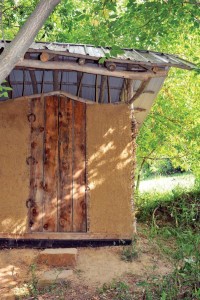
#3 All It Takes Is Effort
Summer and I have developed short- and long-term plans for our homestead. We have focused the majority of our first five years on building the infrastructure of our immediate 2 acres, where we dwell and spend most of our time. This includes the house, blacksmith shop, sauna, washhouse, chicken coop, outhouse, a guesthouse (the newest addition), greenhouse, and a 25-acre fenced pasture for our horses and cattle. We’re happy with our progress in the past five years, but there are still things we wish we had or had done differently, such as building a storage shed sooner. Especially during the first years, having dry storage for wood, tools, hay and personal gear would have been extremely helpful. Tarp mania is never much fun. Looking back, we also wish we had installed an electricity source as soon as possible.
For the first four years, we used a gasoline- powered generator, mostly for cutting lumber during the building process. The noise, stink, and multiple trips to town for more fuel were not ideal, not to mention a greater use of fossil fuel. Originally, we weren’t sure we wanted to have electricity at all. Sometimes our ideals can keep us from healthy progress, and we try to create a balance by knowing when it’s OK to compromise. We now have an off-grid, 700-watt solar system that powers our lights (which used to be candles and propane), some minimal kitchen appliances and my blacksmith shop equipment. We have no refrigerator, freezer, clothes dryer, TV, or water heater. We do have a root cellar, clothesline, computer, and wood-fired hot water.We want to meet face to face or be closely connected to what is involved in the processes of our lives. For example, the day we came to the land, we were able to walk down to the spring and fetch the water we needed. All it took was the effort. When we could afford the expense and were ready for more convenience, we improved our water system by installing a low-cost ram pump (which uses no electricity or fuel), trenching water lines 6 feet deep, and burying an old stainless bulk milk tank uphill for storage. We have gravity-fed water for the house and washhouse, all supplied by the awesome little spring we call Old Faithful. This is one of our greatest signs of independence — free access to clean drinking water.
We heat our water and our home with wood. In the house, we have an old Kitchen Queen wood cookstove and a small propane gas cookstove. We use the Kitchen Queen during the cold season and the gas stove the rest of the year. Getting off of the gas stove would be a huge step toward self-sufficiency, but it would also be a challenge. Our options for taking that step include having an outdoor kitchen (so that we wouldn’t heat ourselves out of the house in summer), cooking more with our little solar cooker, cooking outside over an open fire, and adjusting our diets so that we eat more uncooked foods. We’ll see.
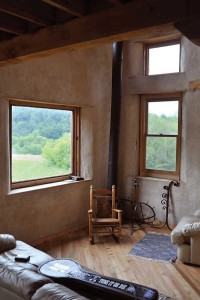
#4 The Next Five Years
Now into our sixth year, we’re looking at what we would like to accomplish in the next five years. We hope to pay off the mortgage. We’re not at the point yet where we make our income from our land. Summer is a massage therapist, and I’m a blacksmith and builder. We both love our professions because they fulfill us creatively, and because we’re able to coordinate our schedules so that our son can stay home with us.
Learning from others has been vital in allowing us to do what we are doing, and now that we’re established, we’re inviting work/study participants to come to our farm and observe what we’re doing. It’s our way of sharing rural skills. We gain friendships, are able to live and work alongside others, and it assists us in the multiple projects we have going. Another way that we have been able to get larger projects done is by having work days. For the past two summers, some good friends and I have teamed up. Together we’ve been able to tackle projects that require more hands, such as putting up new buildings — projects we may have otherwise had to hire labor to complete. Work gets done, and we get to spend time together and become closer to one another.
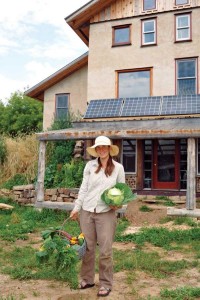
#5 Farming The Land
Agriculturally, we prefer to do things on a small scale. We have three draft horses (for tillage, haymaking, hauling, and snow plowing), four milking goats, a flock of chickens, and two hogs. We’ve experimented with using the hogs for tillage to rid a future growing space of quack grass, and so far so good. We rotated them in a 16-foot-by-32-foot area, and they effectively rooted it up. After we moved the hogs to another area, we immediately cover-cropped the patch with buckwheat and rye. Over a four-month period, we created a new 5,000-square-foot garden space — and we ultimately got meat and lard as well. We have gardens that provide the majority of our produce throughout the year, and with a new greenhouse, we’ll be able to grow greens, lettuce, and herbs through the winter. We have a large raspberry patch and have planted fruit trees, but we could have planted more perennials in those first years so that they would have matured by now. We are also able to sell some of what we grow. I have been growing garlic for nine years and have developed a small market for it.
Goals that we hope to accomplish in the next couple of years include getting the gardens, pasture, and fields to optimum fertility and balance, and creating larger crop fields that will allow us to grow animal feed and potentially put in market produce crops. We’d like to create sections in our fencing so we can better employ a rotational grazing scheme. We have plans to build a much-needed barn in the next year to house the animals under one roof. We’d love to create a haymow for hay storage. We’d also like to use the barn as a dance hall and educational building — agriculture, architecture and the arts, in one place.
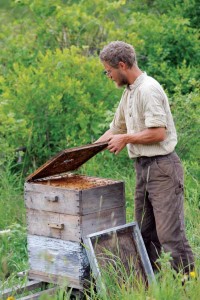
#6 Creating A Fulfilling Life
In living a rural lifestyle, we feel thoroughly fulfilled in our lives. We work hard each day and celebrate with creativity and good food. We enjoy being close to our friends and becoming stronger as a family. These are all things that take time and effort, and it’s what we want to be doing. In the country, it can seem as though one must compromise the arts and culture of the city. But this is one of the reasons we settled in Vernon County, Wis., where there are numerous social things happening. We feel that if we are seeking more “culture,” we should be there to help create it.
One way we have done this is through the Driftless Folk School, a nonprofit organization that focuses on teaching rural skills. We offer classes in a wide variety of subjects, including organic agriculture and cooking, building and woodworking, arts and crafts, and nature studies. Summer took on the task of organizing a music and dance program for the school, and we put on square and contra dances in a lovely community center in the nearby town of LaFarge. Being involved in this organization allows us to do volunteer service, and it helps strengthen our connections to our broader community.
We are so blessed to be living on our land, in the home we built, doing the things we want to be doing. We are guided by our conscience, supported by our friends and family, and inspired by what’s to come. The struggles we face often bring frustration, but the realization that we can pull through and grow stronger from such experiences has made us eager to take on the next challenge in front of us. With a spirit of innovation and a love for simplicity and living wisely, we wake up each morning with ambition. We hope to inspire others as we have been inspired, and we look to the future with optimism. With a spirit of innovation and a love for living wisely, we wake up each morning with ambition.
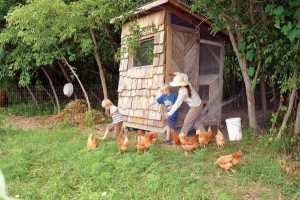

Leave a Reply